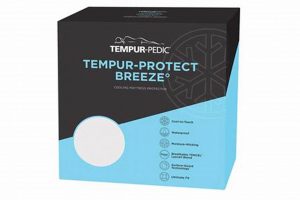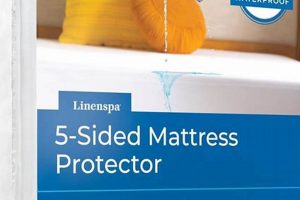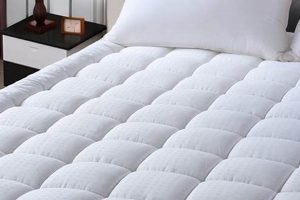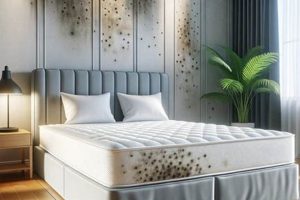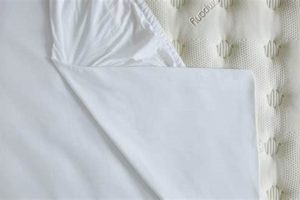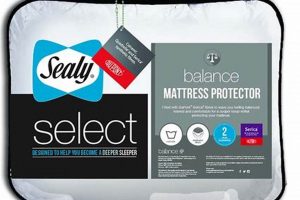A specialized covering designed to shield a bed’s surface, particularly those constructed from viscoelastic foam, is a crucial component for maintaining the hygiene and longevity of such sleep surfaces. These covers offer a barrier against liquids, allergens, and dust mites, thereby preserving the integrity and comfort of the underlying material. Consider, as an example, a waterproof, breathable layer placed over a viscoelastic foam mattress to prevent spills from seeping into the foam and causing irreparable damage.
The implementation of such protective measures offers several notable advantages. They safeguard against staining and degradation caused by moisture, thereby extending the lifespan of the investment. Furthermore, these barriers contribute significantly to a healthier sleep environment by reducing exposure to common allergens and irritants. Historically, simpler fabrics were employed for this purpose; however, modern advancements in materials science have led to the development of sophisticated, high-performance options that offer superior protection and breathability.
The following sections will delve into the key considerations for selecting an appropriate safeguard, exploring various types of materials, features, and performance characteristics, to ensure an informed decision can be made. These aspects will equip the reader with the knowledge needed to optimize the preservation of their sleep surface and enhance their overall sleep quality.
Enhancing Longevity
The following guidelines offer practical strategies for maximizing the protective benefits, thereby extending the life and maintaining the hygiene of the underlying sleep surface.
Tip 1: Prioritize Waterproofing. Fluid resistance is paramount. Opt for a model specifically designed to prevent liquid penetration, safeguarding against spills, perspiration, and other potential sources of moisture damage. Consider a polyurethane film backing, a common and effective waterproofing method.
Tip 2: Ensure Breathability. While waterproofing is essential, breathability prevents moisture buildup and promotes airflow, reducing the risk of mold and mildew growth. Look for materials such as cotton terry or bamboo rayon paired with a waterproof membrane that allows for vapor transmission.
Tip 3: Consider Allergen Resistance. Dust mites are a common concern. Select a product with a tightly woven fabric that acts as a barrier against these allergens. Regularly laundering the covering further minimizes allergen accumulation.
Tip 4: Evaluate Material Composition. The composition dictates both performance and comfort. Natural fibers like cotton offer breathability and softness, while synthetics can provide enhanced durability and waterproofing. Assess material properties based on individual needs and preferences.
Tip 5: Check for a Secure Fit. A proper fit is crucial for effective protection. Ensure the covering fits snugly and securely over the entire sleep surface, preventing shifting and exposure to potential hazards. Deep-pocket designs are often beneficial for thicker mattresses.
Tip 6: Follow Care Instructions. Adhering to the manufacturer’s care instructions is essential for maintaining its protective qualities. Regular laundering, as specified, will remove accumulated dust, allergens, and other contaminants.
Tip 7: Read Reviews. Before making a purchase, consult reviews from other consumers to gain insights into real-world performance, durability, and comfort. Pay attention to feedback regarding waterproofing effectiveness, breathability, and overall satisfaction.
Implementing these tips will contribute to a cleaner, healthier, and more durable sleep environment, safeguarding the viscoelastic foam from potential damage and extending its useful life.
The subsequent sections will explore specific product categories and address common concerns related to maintenance and long-term performance, providing a comprehensive overview of the topic.
1. Waterproof Barrier
The presence of a waterproof barrier is a defining characteristic of an effective covering for viscoelastic foam mattresses. This feature is essential for safeguarding the foam’s integrity and extending its lifespan by preventing the absorption of liquids.
- Protection Against Spills and Accidents
A primary function is to shield the foam from accidental spills of beverages, bodily fluids, or other liquids. Viscoelastic foam is highly absorbent, and once liquid penetrates, it can be difficult, if not impossible, to remove completely. This can lead to staining, odor, and degradation of the foam’s structural integrity. The waterproof layer acts as a preventative measure, maintaining the mattress in a sanitary and functional condition.
- Prevention of Mold and Mildew Growth
Moisture trapped within foam creates a breeding ground for mold and mildew. These microorganisms can cause allergic reactions and respiratory problems. A waterproof barrier effectively prevents moisture from reaching the foam, thereby inhibiting the growth of these harmful substances. This is particularly important in humid environments or for individuals prone to night sweats.
- Maintenance of Mattress Warranty
Many mattress warranties are voided if the mattress is stained or damaged by liquids. Utilizing a waterproof covering can help maintain the validity of the warranty by preventing liquid damage. This provides a layer of financial protection in the event of manufacturing defects or other covered issues.
- Hygiene and Sanitation
The waterproof layer also serves as a barrier against the accumulation of dust mites, allergens, and other contaminants that can penetrate traditional fabrics. This promotes a cleaner and more hygienic sleep surface, particularly beneficial for individuals with allergies or asthma. Regular cleaning of the waterproof covering further enhances the cleanliness of the sleep environment.
In summation, the incorporation of a waterproof barrier is an indispensable aspect of a protective layer for viscoelastic foam mattresses. It provides essential defense against liquid damage, promotes a hygienic sleep environment, and contributes to the overall longevity and usability of the mattress. The effectiveness of this feature is paramount in selecting a product that delivers sustained performance and value.
2. Breathable materials
Breathable materials play a critical role in the functionality and effectiveness of a protective layer for viscoelastic foam mattresses. The selection of appropriate breathable materials directly influences comfort, hygiene, and the overall lifespan of the sleep surface. The following examines key facets of breathable materials in this context.
- Moisture Vapor Transmission
Breathable materials facilitate the transmission of moisture vapor away from the body. This is particularly important as viscoelastic foam tends to retain heat and can exacerbate perspiration during sleep. Materials with high moisture vapor transmission rates prevent the accumulation of moisture on the mattress surface, reducing the risk of discomfort and potential microbial growth. Examples include cotton, Tencel, and bamboo-derived fabrics, which allow for the efficient passage of moisture molecules.
- Air Circulation and Temperature Regulation
Effective air circulation is integral to maintaining a comfortable sleep temperature. Breathable fabrics promote airflow, dissipating heat and preventing overheating. This is particularly beneficial for individuals who experience night sweats or live in warmer climates. Materials with open weaves or specialized constructions, such as those incorporating micro-perforations, enhance air circulation and contribute to temperature regulation. This helps to sustain a consistently comfortable sleep environment.
- Prevention of Mold and Mildew
Excessive moisture accumulation creates an environment conducive to mold and mildew growth. The use of breathable materials helps mitigate this risk by allowing moisture to evaporate, preventing its buildup within the mattress. Materials with inherent antimicrobial properties, such as merino wool or certain synthetic blends, provide an additional layer of protection against microbial proliferation. This promotes a healthier and more hygienic sleep surface.
- Comfort and Tactile Properties
The selection of breathable materials also impacts the tactile feel and overall comfort. Fabrics that are soft, smooth, and non-irritating contribute to a more pleasant sleep experience. Materials such as cotton or Tencel are known for their comfort and gentle feel against the skin. These materials enhance the overall sleep quality by minimizing discomfort and promoting relaxation.
In conclusion, the choice of breathable materials is a critical factor in determining the effectiveness and suitability of a protective covering for viscoelastic foam mattresses. These materials contribute to moisture management, temperature regulation, hygiene, and overall comfort, ultimately influencing the lifespan and usability of the sleep surface. Selecting materials with optimal breathable properties is essential for maximizing the benefits of the protective layer.
3. Allergen resistance
The capacity to resist allergens is a crucial performance criterion in the selection of an optimal protective covering for viscoelastic foam mattresses. The porous nature of viscoelastic foam renders it susceptible to the accumulation of allergens such as dust mites, pet dander, and mold spores. These allergens can trigger allergic reactions and respiratory issues in susceptible individuals. Therefore, the integration of allergen-resistant features into the protective layer is essential for promoting a healthy sleep environment.
The most common approach to achieving allergen resistance involves utilizing tightly woven fabrics that serve as a physical barrier, preventing allergens from penetrating the mattress core. Fabrics such as microfiber or tightly woven cotton are effective in blocking the passage of dust mites, a primary allergen source in bedding. Additionally, some protective covers incorporate antimicrobial treatments that inhibit the growth of mold and bacteria, further reducing the potential for allergenic exposure. An example of this is the use of silver-infused fabrics, which possess inherent antimicrobial properties. Proper selection of a cover boasting these features ensures a reduction in allergen concentration within the sleeping environment. Without such protection, individuals with sensitivities may experience exacerbated allergic symptoms, impacting sleep quality and overall health.
In summary, allergen resistance constitutes a significant attribute of a high-quality protective covering for viscoelastic foam mattresses. By minimizing allergen accumulation and inhibiting microbial growth, these coverings contribute to a cleaner, healthier, and more comfortable sleep experience. The practical significance of this understanding lies in its ability to guide informed purchasing decisions, ultimately improving the well-being of mattress users, especially those with allergies or respiratory conditions. Prioritizing this feature addresses a fundamental concern related to indoor air quality and promotes long-term sleep health.
4. Secure fit
A secure fit is a fundamental characteristic of any protective covering designed for viscoelastic foam mattresses. It directly impacts the effectiveness of the covering in safeguarding the mattress and providing a comfortable sleep surface.
- Full Coverage and Protection
A snug, secure fit ensures complete coverage of the mattress, preventing exposure to spills, stains, allergens, and dust mites. Gaps or loose areas can compromise the protective barrier, allowing contaminants to reach the foam. This is particularly crucial for viscoelastic foam, which is highly absorbent and difficult to clean once soiled. A well-fitting cover effectively seals the mattress, maintaining its cleanliness and prolonging its lifespan.
- Prevention of Shifting and Bunching
A secure fit minimizes shifting and bunching of the cover during sleep. Movement of the covering can create discomfort, disrupt sleep, and reduce the effectiveness of its protective properties. A tight fit, often achieved through elasticized edges or fitted sheet designs, keeps the cover firmly in place, providing a smooth and consistent sleep surface. This is essential for maintaining comfort and preventing sleep disturbances caused by an uneven or wrinkled covering.
- Compatibility with Mattress Depth
A secure fit requires selecting a product that is appropriately sized for the mattress’s depth. Deep-pocket designs are necessary for thicker mattresses to ensure adequate coverage and prevent the cover from slipping off. Inadequate depth can lead to insufficient protection of the mattress sides and corners, leaving these vulnerable to damage. Selecting the correct size is paramount for achieving a secure and effective fit.
- Enhanced Comfort and Sleep Quality
By minimizing movement and ensuring a smooth, even surface, a secure fit contributes to improved comfort and sleep quality. A properly fitting cover eliminates distractions caused by shifting or bunching, allowing for a more restful sleep experience. The secure fit also ensures that the protective properties of the covering are consistently maintained, safeguarding the mattress and promoting a healthier sleep environment.
Therefore, prioritizing a secure fit when selecting a mattress protector is essential for optimizing the protective benefits and ensuring long-term satisfaction. A properly fitted cover safeguards the viscoelastic foam from damage, promotes a comfortable sleep surface, and contributes to the overall lifespan and usability of the mattress. Overlooking this aspect can significantly compromise the effectiveness and value of the protective covering.
5. Easy maintenance
The ease with which a protective mattress covering can be maintained is a crucial factor in determining its overall suitability, particularly for viscoelastic foam mattresses. The practical demands of hygiene and the prevention of allergen accumulation necessitate regular cleaning, making ease of maintenance a key characteristic of a high-quality product.
- Machine Washability
The ability to machine wash a mattress covering significantly simplifies the cleaning process. This feature allows for the convenient removal of dust, allergens, and other contaminants without requiring specialized cleaning services. For instance, a viscoelastic foam mattress covering that can be laundered in a standard washing machine promotes regular cleaning and enhances the hygiene of the sleep surface. The lack of this feature often leads to infrequent cleaning, resulting in the accumulation of allergens and a diminished sleep environment.
- Drying Considerations
The method and speed with which a covering can be dried are important aspects of easy maintenance. Materials that are quick-drying reduce the risk of mildew growth and allow for prompt replacement on the mattress. Protective coverings that can be safely dried in a standard dryer minimize the need for air drying, further streamlining the cleaning process. Conversely, coverings that require extensive air drying can be less practical, particularly in humid climates.
- Stain Resistance
Materials that exhibit inherent stain resistance simplify the removal of spills and other blemishes. Protective coverings constructed from fabrics that resist staining require less frequent and less intensive cleaning. For example, a polyurethane laminate covering may repel liquids and prevent them from penetrating the fabric, reducing the likelihood of permanent staining. This characteristic minimizes the effort required to maintain a clean and hygienic sleep surface.
- Durability Through Washing Cycles
A key consideration is the covering’s ability to withstand multiple washing cycles without losing its protective properties or structural integrity. A high-quality mattress covering should maintain its waterproofing, breathability, and secure fit even after repeated laundering. Coverings that degrade quickly through washing require more frequent replacement, negating the benefits of easy maintenance. Therefore, durability is a critical factor in assessing the long-term practicality of a viscoelastic foam mattress covering.
In summary, the concept of easy maintenance encompasses several key factors, including machine washability, drying considerations, stain resistance, and durability through washing cycles. These attributes collectively contribute to the practicality and long-term suitability of a viscoelastic foam mattress covering, ensuring that it remains effective and hygienic with minimal effort. Prioritizing these features when selecting a product maximizes its value and promotes a cleaner, healthier sleep environment.
Frequently Asked Questions
This section addresses common inquiries and misconceptions regarding the selection and use of protective coverings for viscoelastic foam mattresses. The information presented aims to provide clarity and guide informed decision-making.
Question 1: Is a specialized mattress protector necessary for viscoelastic foam?
Yes, a dedicated protective covering is highly recommended. Viscoelastic foam’s porous structure makes it susceptible to liquid absorption and allergen accumulation. A protector provides a barrier against these threats, prolonging the mattress’s lifespan and maintaining hygiene.
Question 2: What are the key features to consider when selecting a protector?
Essential features include waterproofing, breathability, allergen resistance, a secure fit, and ease of maintenance. Waterproofing prevents liquid damage, breathability promotes airflow, allergen resistance minimizes exposure to allergens, a secure fit ensures complete coverage, and easy maintenance simplifies cleaning.
Question 3: How does breathability impact the performance of a mattress protector?
Breathability allows moisture vapor to escape, preventing moisture accumulation within the mattress. This reduces the risk of mold and mildew growth, contributing to a healthier sleep environment and preventing degradation of the foam’s structure.
Question 4: Can a mattress protector affect the comfort of a viscoelastic foam mattress?
Yes, the material and design of the protector can influence comfort. Selecting a protector made from soft, breathable materials can enhance comfort and minimize any alterations to the feel of the viscoelastic foam. Conversely, a poorly designed protector can feel stiff or retain heat, impacting sleep quality.
Question 5: How often should a mattress protector be cleaned?
The recommended cleaning frequency is typically every one to two months, or more often if spills occur. Regular cleaning removes accumulated dust, allergens, and other contaminants, maintaining a hygienic sleep surface.
Question 6: Will a mattress protector void the mattress warranty?
No, using a mattress protector will not typically void the warranty. In fact, many mattress manufacturers recommend the use of a protector to prevent stains and damage, which can void the warranty if the mattress is left unprotected.
The information provided highlights the importance of selecting a mattress protector that meets specific needs and preferences, ensuring the longevity and hygiene of the viscoelastic foam mattress.
The subsequent section will delve into a comparative analysis of various protector types, providing further guidance for informed decision-making.
Concluding Remarks
The preceding analysis has explored the salient characteristics of a product category designed to safeguard viscoelastic foam mattresses. Considerations such as waterproofing, breathability, allergen resistance, secure fit, and ease of maintenance constitute crucial determinants in evaluating the efficacy of any purported “best mattress protector for memory foam mattress.” The absence of any of these attributes can compromise the long-term integrity, hygiene, and comfort of the underlying sleep surface.
Therefore, a rigorous assessment of these factors remains paramount when selecting a protective covering. The ultimate objective is to secure a product that not only preserves the viscoelastic foam’s structural integrity and cleanliness but also contributes to a healthy and comfortable sleep environment. The informed application of these principles will facilitate a more judicious purchasing decision, yielding long-term benefits for both the mattress and its user.


